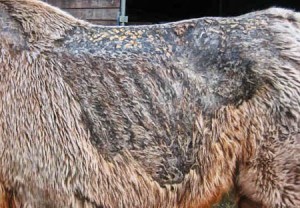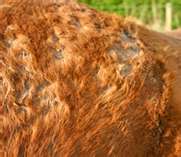Rain Scald Explained
Written By– Dr. John Kohnke BVSc RDA.
Talking Horses Equestrian Issue 22
Rain Scald or ‘mud fever’ is a common skin condition which is favoured by wet weather. The common cause is a fungal-like organism (Dermatophilus congolensis) which colonises the skin of horses, cattle and sheep. 
Horses which share pastures with sheep or cattle often have a higher risk of rain scald or even ‘greasy heel’, which is also caused by the same organism, combined with skin reaction to sunlight on non-pigmented skin (horses with white socks on their hind fetlocks and pasterns).
Although it is a soil contaminate, it is difficult to culture the fungal-like organism from soil in muddy areas. Studies have shown that the common black house fly (Musca domestica), which are often prevalent in large numbers after rain as they breed in manure, can spread the organism as they swarm around and transfer it to horses via their legs and feeding proboscis.
There are various forms of rain scald, ranging from ‘cinder’ or ‘sand’ burn on the front of the hind limbs of working horses, to greasy heel and generalised infection in foals kept in muddy conditions.
Horses with areas of no pigmented skin are highly susceptible when they have a solar UV sensitivity and are grazing wet pastures. The infected areas feel warmer to the touch and are often matted and painful in severe infections.
Wet Conditions Favour Rain Scald
The rain scald organism is a common inhabitant on the skin of horses, but under ideal wet and warm conditions, it will invade the skin. The skin on the flat parts of the body of the head, withers, top-line and rump are more likely to be affected as water from rain cannot drain away as quickly to dry the skin.
 Light, misty rain favours the fungal colonisation on the head and legs, especially on horses grazing on long grass which keeps wetting and can abrade the skin.
Light, misty rain favours the fungal colonisation on the head and legs, especially on horses grazing on long grass which keeps wetting and can abrade the skin.
Young, Aged and New Horses are Most Vulnerable
Horses which have been challenged or partly infected often develop some degree of immunity to invasion by the organism. However, horses turned out from dry stables into wet weather and highly contaminated soil and pasture, are more likely to develop rain scald within a few days.
Young and aged horses with poor skin immunity or newly introduced horses from a property with low contamination, are also likely to develop and suffer from acute or chronic rain scald, as well as greasy heel.
After a period of wet overcast weather, horses kept outdoors are more likely to develop severe form of rain scald along the top-line and rump. Often Staph. bacteria create a secondary infection to increase the degree of irritation especially if the horse rolls on contaminated dust or mud in a yard, resulting in skin inflammation and oozing exudates, which can mat the hair over infected areas.
| Diagnosis of Rain Scald Diagnosis is based on the typical lesions with loss of hair in tufts, heat and swelling, leaving a ‘juicy’ or pus-filled crater, or small hard, sensitive and itchy lumps under the saddle and tack. This is often caused by the secondary invasion with Staph species bacteria harboured on the skin. The skin can be swabbed and then the samples cultured, or the skin layer biopsied, to identify the organism and confirm the diagnosis. |
| Treating Rain Scald Infections with lesions on the head, neck, top-line and rump can be effectively treated by washing the animal in a 10% Betadine or Vetadine® soapy wash, allowing it to stay on the coat for 10-15 minutes to release the iodine before rinsing it off. This should be repeated every second day for 2-3 washes. If possible, shift the horse indoors to a dry stable with clean bedding to keep the horse out of the mud and the rain. Where infections are persistent or recur in young or old horses with poor skin immunity, a course of antibiotics, as prescribed by your vet, may be required to clean up the secondary infection and allow the animal’s immunity to develop resistance, albeit weak, against the organism. |


